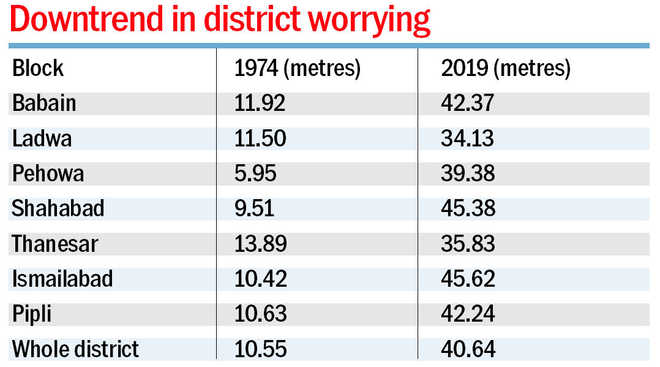Nitish Sharma
The groundwater level in Kurukshetra has fallen drastically. To tackle the alarming situation, the district administration has planned to install 80 rainwater harvesting systems at government schools and buildings by September this year. The groundwater level in Kurukshetra has decreased by 30.09 metres in the last 45 years.
According to the available data, the groundwater level in the district in 1974 was 10.55 metres but it has now dropped to 40.64 metres. In June 1974, the groundwater level in Babain block was 11.92 metres, Ladwa 11.50 metres, Pehowa 5.95 metres, Shahabad 9.51 metres, Thanesar 13.89 metres, Ismailabad 10.42 metres, and in Pipli 10.63 metres.
According to a report of June 2019, the groundwater level has dropped to 42.37 metres in Babain block, 34.13 metres in Ladwa, 39.38 metres in Pehowa, 45.38 metres in Shahabad, 35.83 metres in Thanesar, 45.616 metres in Ismailabad, while in Pipli it has fallen to 42.24 metres.
The Central Ground Water Authority had banned the issuance of tubewell connections for agriculture in Ladwa and Pehowa blocks in 2011 and in Shahabad in 2006.
Parth Gupta, Additional Deputy Commissioner (ADC), Kurukshetra, says, “The groundwater level in Kurukshetra district is decreasing by nearly two metres every year, which is a matter of serious concern for us. Paddy consumes a huge amount of water and in order to save groundwater, farmers have to come forward and start cultivating other crops too. Officials of the Agriculture Department will have to be more active and farmers have to be motivated to adopt crop diversification. By replacing paddy with maize, ‘arhar’ and other crops, farmers will not only save water and electricity but will also increase their income and the productivity of the land”.
“Due to overexploitation of underground water, the situation has worsened in all seven blocks of the district. New recharge pits will also be constructed and the work will be taken up under MNREGA,” says Gupta, who is also the nodal officer for the Jal Shakti Abhiyan.
He says that the work will be completed by the end of September this year. The existing rainwater harvesting systems are being checked and cleaned to ensure that they work properly. A campaign will be run to motivate and educate people about the need to save water, he adds.
According to the plan, 10 to 15 rainwater harvesting systems will be installed in every block so that rainwater can be saved. These systems will be installed only in government schools and buildings.
The district administration has also sought cooperation from farmers and is also motivating them to adopt crop diversification. In the current season, around 7,000 hectares out of total 18,200 hectares available in Thanesar block, on which usually non-basmati rice varities is cultivated, is being used to grow non-paddy crops such as maize and ‘arhar’. At present, over 37,277 tubewells in the district are being used for irrigation.
Unlock Exclusive Insights with The Tribune Premium
Take your experience further with Premium access.
Thought-provoking Opinions, Expert Analysis, In-depth Insights and other Member Only Benefits
Already a Member? Sign In Now










